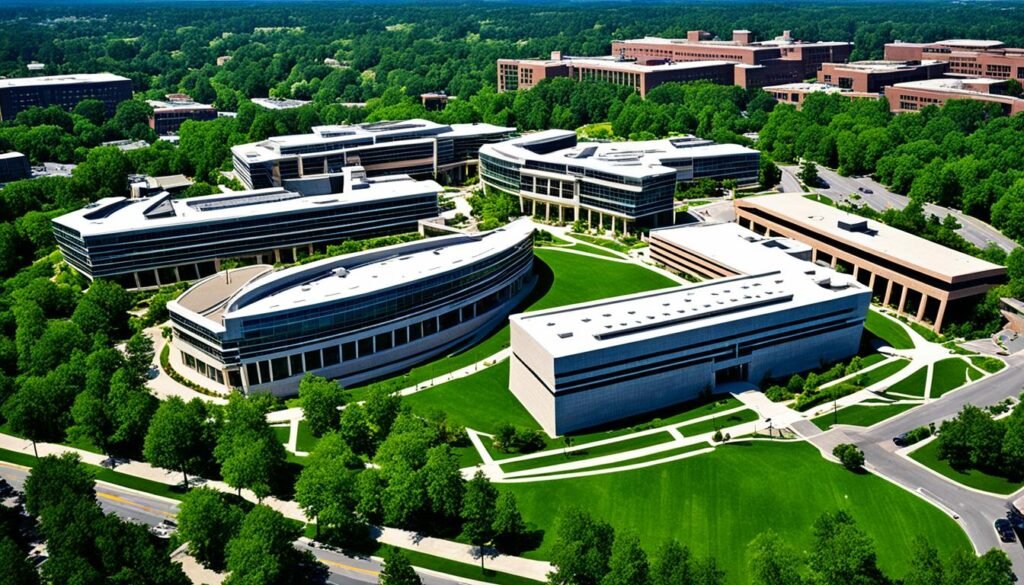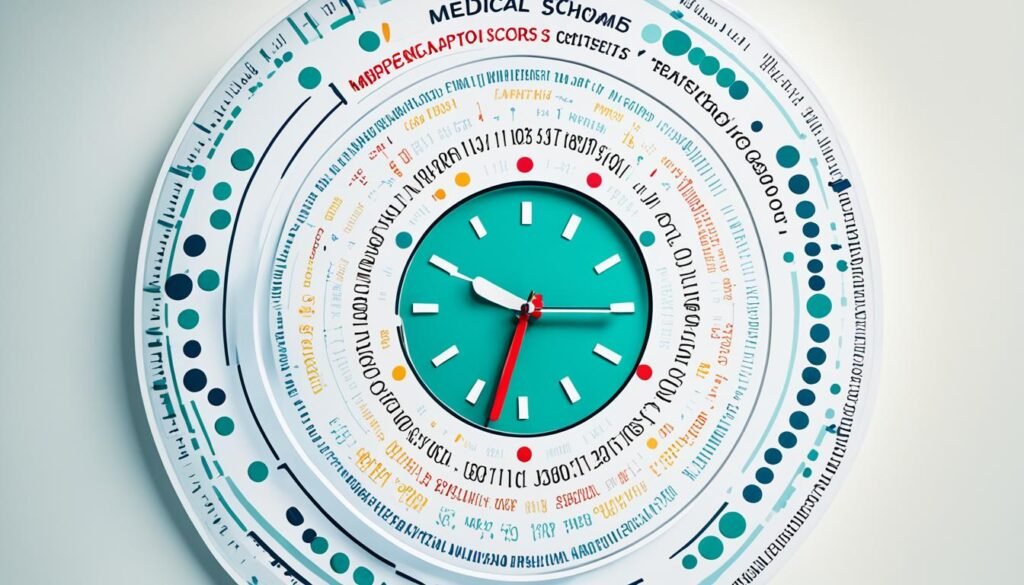Choosing the right medical school is crucial for aspiring medical professionals. U.S. News provides unbiased rankings and profiles of the best medical schools in the USA, based on data and expert interviews. This comprehensive guide will help prospective medical school students make informed decisions about their education and future careers.
Key Takeaways:
- Best Medical Schools
- Top Medical Schools
- Medical School Rankings
- Best Med Schools
- Medical School Admission
- Medical Education Programs
Factors to Consider When Choosing a Medical School
Admission to medical schools is highly competitive. It requires more than just good grades and a high score on the MCAT. While academic achievements play an important role, there are several other factors to consider when choosing the right medical school for you.
Medical School Requirements
Each medical school has its own specific requirements for admission. It is crucial to thoroughly research and understand these requirements before applying. They may include prerequisite courses, minimum GPA, letters of recommendation, and extracurricular activities. Adhering to these requirements will increase your chances of acceptance.
Getting into Medical School
Getting into medical school is a competitive process. Your academic performance, especially in science courses, will greatly influence your chances of acceptance. However, it is not the only determining factor. Admissions committees also consider your personal statement, extracurricular activities, community involvement, and unique experiences that demonstrate your commitment to the field of medicine.
Medical School Acceptance
Acceptance rates vary among medical schools. It is important to assess your chances realistically before applying. Consider your academic record, MCAT scores, and extracurricular activities compared to the average accepted applicant at each school. This will help you create a list of schools that align with your qualifications and increase your chances of acceptance.
Medical School Tuition
Medical school tuition can be a significant financial burden. It is essential to understand the cost of tuition, as well as additional expenses such as textbooks, supplies, and living arrangements. Take into account your financial situation and explore scholarship opportunities, grants, and loan options to support your education.
“The cost of medical school can be significant, with some top-ranked schools charging upwards of $70,000 per year.”
Consider the financial implications of attending each school and ensure you have a plan in place to manage expenses throughout your medical education.
Choosing the right medical school is a decision that will shape your future as a healthcare professional. By carefully considering and researching factors such as admission requirements, acceptance rates, and financial implications, you can make an informed decision that aligns with your goals and sets you on the path to a successful medical career.
Top Medical Schools in the USA

When it comes to pursuing a medical education, some institutions stand above the rest. U.S. News has ranked the top medical schools in the USA based on their programs, research, and reputation. Aiming for excellence, these schools provide aspiring medical professionals with the knowledge and skills necessary to make significant contributions to the field of medicine.
The top medical schools recognized by U.S. News include:
- Harvard Medical School
- Stanford Medical School
- Johns Hopkins University School of Medicine
- Yale School of Medicine
- University of Pennsylvania Perelman School of Medicine
Harvard Medical School, located in Boston, Massachusetts, is renowned for its innovative curriculum and commitment to advancing medical knowledge. Stanford Medical School, situated in Stanford, California, offers a range of cutting-edge programs and fosters collaboration between disciplines. Johns Hopkins University School of Medicine, located in Baltimore, Maryland, is internationally recognized for its research efforts and commitment to patient care.
Yale School of Medicine, situated in New Haven, Connecticut, focuses on educating doctors who will become leaders in medicine. Lastly, the University of Pennsylvania Perelman School of Medicine, located in Philadelphia, Pennsylvania, offers exceptional education and research opportunities.
These top medical schools provide aspiring medical professionals with extensive resources, clinical training, and exposure to groundbreaking research. In addition, they attract renowned faculty members who are leaders in their respective specialties, ensuring that students receive the highest quality education.
Medical Education and Training

Medical education is a comprehensive process that extends beyond the four years of medical school. After obtaining their medical degree, aspiring doctors continue their training through residency programs and fellowship programs to further specialize in their chosen field. These programs provide invaluable hands-on experience and mentorship opportunities, preparing medical professionals for the challenges they will face in their careers.
A residency program is a postgraduate training program that focuses on a specific medical specialty. It typically lasts between three to seven years, depending on the specialty. During this period, residents work alongside experienced physicians in a clinical setting, providing patient care under supervision. This immersive training allows residents to develop critical decision-making skills and gain expertise in their chosen specialty.
Fellowship programs, on the other hand, are optional additional training programs that follow the completion of a residency. They provide further specialization in a specific subfield within a medical specialty. Fellowship programs generally last between one to three years, during which fellows work closely with experts in their chosen subspecialty. These programs offer specialized training, research opportunities, and the chance to further enhance skills and knowledge in a specific area.
Benefits of Residency Programs and Fellowship Programs:
- Practical and hands-on experience in a clinical setting
- Opportunities for mentorship and guidance from experienced physicians
- Specialization in a specific medical specialty or subspecialty
- Exposure to the latest advancements and research in the field
- Networking opportunities with professionals in the medical community
- Preparation for board certification in a chosen specialty
The demanding nature of medical education and training requires dedication, perseverance, and a commitment to lifelong learning. Medical professionals continuously update their knowledge and skills to stay at the forefront of medical advancements and provide the best possible care to their patients.
Completing a medical education program and training through residency and fellowship programs equips medical professionals with the necessary skills and knowledge to make a positive impact in the field of medicine. Whether it’s diagnosing and treating patients, conducting research, or leading medical teams, the extensive education and training journey prepares medical professionals for the challenges and rewards of their chosen medical career.
The Value of a Medical Degree

Pursuing a medical degree is a major commitment, both in terms of time and financial investment. However, for individuals with a passion for medicine and a dedication to patient care, it can be a rewarding and fulfilling career choice. With a medical degree, graduates have the opportunity to make a significant impact in the healthcare field and specialize in various medical specialties.
Medical professionals play a vital role in society. They are responsible for diagnosing and treating illnesses, improving patient outcomes, and promoting overall well-being. Through their expertise and knowledge, they contribute to the advancement of medical science and the development of new treatment options.
Medical careers are diverse and offer a wide range of opportunities for personal and professional growth. Whether one chooses to become a primary care physician, a surgeon, a specialist in a specific medical field, or pursue a career in medical research or academia, a medical degree provides a solid foundation for a successful career.
Medical professionals also have the opportunity to specialize in specific medical specialties. These specialties allow them to focus their expertise and skills on a particular area of medicine, such as cardiology, dermatology, or pediatrics. By specializing, medical professionals can deepen their knowledge, develop advanced techniques, and deliver specialized care to patients.
Moreover, a medical degree opens doors to various employment opportunities, including positions in hospitals, clinics, research institutions, pharmaceutical companies, and public health organizations. The demand for competent medical professionals remains high, creating a favorable job market for those with a medical degree.
Furthermore, a medical career is not only financially rewarding, but it also provides a sense of fulfillment and purpose. Medical professionals have the privilege of helping others, making a positive difference in people’s lives, and contributing to the overall well-being of their communities.
The Impact of Medical Professionals
“As medical professionals, our primary goal is to provide the highest level of care to our patients. We have the opportunity to impact lives, promote health, and contribute to medical advancements. It is a challenging but incredibly fulfilling journey.” – Dr. Emily Johnson, MD
With population growth and advancements in healthcare technology, the need for skilled medical professionals is expected to continue growing. The demand for doctors, nurses, and other healthcare professionals remains steady, ensuring ample job opportunities and job security for those with a medical degree.
Ultimately, a medical degree offers not only a promising career path but the chance to make a lasting impact on individuals and communities. It is a profession that requires passion, dedication, and a commitment to lifelong learning. For those willing to invest in their education and embark on the journey to become a medical professional, the rewards are immeasurable.
Financial Considerations for Medical School Students

Attending medical school is a significant investment that often comes with a substantial financial burden. The high cost of tuition and related expenses can lead to the accumulation of student loan debt for many aspiring medical professionals. However, there are various options available to alleviate this financial strain and make medical education more affordable.
Student Loan Debt
Student loan debt is a common concern for medical school students. The cost of tuition, books, housing, and other expenses can quickly add up, resulting in significant debt upon graduation. It is crucial for students to understand the long-term impact of student loans and develop strategies to manage and repay their debt responsibly.
While student loans are often necessary to finance medical education, it is essential to research and compare different loan options, such as federal loans, private loans, and loan forgiveness programs. Taking the time to understand the terms, interest rates, and repayment options can help students make informed decisions and minimize their student loan debt in the long run.
Medical School Scholarships
One way to offset the financial burden of medical school is through scholarships. Many organizations, institutions, and foundations offer scholarships specifically for medical school students. These scholarships can be merit-based, need-based, or specific to certain medical specialties.
It is crucial for prospective medical school students to explore scholarship opportunities and research eligibility criteria and application deadlines. Applying for scholarships can be competitive, but dedicating time and effort to scholarship applications can pay off significantly in terms of reducing the overall cost of medical education.
Financial Aid for Medical School
Besides scholarships, financial aid options such as grants, work-study programs, and need-based aid can provide additional support to medical school students. Students should research and understand the financial aid options offered by their chosen medical schools, as well as federal and state assistance programs.
Completing the Free Application for Federal Student Aid (FAFSA) is a crucial step in applying for financial aid. The FAFSA determines a student’s eligibility for federal grants, work-study opportunities, and loans. It is essential to consult with the financial aid offices of prospective medical schools to explore all available options and create a comprehensive financial plan.
“Exploring scholarship opportunities and understanding the range of financial aid options available can help aspiring medical professionals minimize their student loan debt and alleviate the financial burden of medical school.”
Planning and Budgeting
Creating a realistic financial plan and budget is essential for medical school students. It is crucial to estimate expenses, including tuition, housing, textbooks, transportation, and living costs, to ensure a comprehensive understanding of the financial commitment required.
Students should develop a budget that allows for responsible spending and saving during their education. This includes exploring ways to minimize expenses, such as living frugally, considering roommates, and utilizing resources available on campus or within the community.
Additionally, seeking financial advice from professionals, such as financial advisors or counselors, can provide valuable guidance on managing expenses, budgeting effectively, and making sound financial decisions throughout medical school.
Financial Considerations Table
| Financial Consideration | Description |
|---|---|
| Student Loan Debt | Accumulation of debt due to high tuition costs and related expenses. |
| Medical School Scholarships | Financial assistance provided based on merit, need, or specialization. |
| Financial Aid | Grants, work-study programs, and need-based aid to support medical school expenses. |
| Planning and Budgeting | Developing a comprehensive financial plan and budget to manage expenses. |
By exploring scholarship opportunities, understanding financial aid options, and creating a comprehensive financial plan, prospective medical school students can alleviate the financial burden associated with medical education. It is crucial to take an informed and proactive approach to manage finances throughout medical school, enabling students to focus on their studies and pursue their passion for medicine.
Application Process and Timeline

The process of applying to medical schools can be intricate and requires meticulous planning. Aspiring medical students who wish to pursue an M.D. degree typically utilize the American Medical College Application Service (AMCAS), while those interested in a D.O. degree opt for the American Association of Colleges of Osteopathic Medicine Application Service (AACOMAS).
It is advisable for students to commence their preparation for the medical school application process at least two to three years in advance. This includes studying for and taking the Medical College Admission Test (MCAT), fulfilling prerequisite courses, and gaining clinical experience.
When applying through AMCAS or AACOMAS, students are required to provide pertinent information such as academic achievements, extracurricular activities, personal statements, and letters of recommendation. The application systems allow students to apply to multiple medical schools simultaneously, streamlining the process and saving time.
Medical School Application Timeline
Here is a general timeline to help aspiring medical students navigate the application process:
- 1-2 years before applying: Start researching medical schools, prerequisite coursework, and clinical experience opportunities. Begin studying for the MCAT.
- 1 year before applying: Register and take the MCAT. Request letters of recommendation from professors or professionals who can attest to your abilities and qualifications.
- Spring/Summer: Complete AMCAS or AACOMAS application. Draft and refine personal statements and essays.
- Fall: Submit primary applications to medical schools promptly. Some schools have rolling admissions, so early completion is advantageous.
- Winter: Prepare for and attend medical school interviews. Submit secondary applications and any additional required documents.
- Spring: Continue attending interviews. Make final decisions after receiving acceptance offers.
- Summer: Prepare for medical school by completing any necessary requirements and organizing your transition.
It is important to note that the timeline may vary depending on individual circumstances and the specific requirements of the medical schools you are applying to. Remaining organized, starting early, and seeking guidance from pre-med advisors can help ensure a smooth application process.
Having a clear understanding of the application process and adhering to a well-defined timeline is crucial for prospective medical school students. By carefully following the steps outlined above and being proactive in seeking guidance, aspiring medical professionals can enhance their chances of acceptance into their desired institutions.
Unique Programs and Opportunities

When it comes to pursuing a medical career, it’s not just about choosing the right medical school. Many institutions offer unique programs and opportunities that can enhance your education and open doors to exciting career prospects. These opportunities allow you to delve deeper into specific areas of interest and gain valuable experience along the way.
Medical Research
Medical research plays a crucial role in advancing healthcare and improving patient outcomes. Many medical schools offer research programs that allow students to work alongside esteemed faculty members and contribute to groundbreaking discoveries. Engaging in medical research not only deepens your understanding of medical science but also equips you with valuable skills in critical thinking, data analysis, and problem-solving.
Global Health Programs
In today’s interconnected world, global health has become an integral part of medical practice. Medical schools often offer global health programs that provide students with opportunities to work in underserved communities abroad and gain firsthand experience in addressing global health challenges. These programs foster cultural competence, empathy, and a broader perspective on healthcare disparities, preparing you to make a difference in both local and international contexts.
Joint Degree Programs
Collaboration across different disciplines is becoming increasingly important in the field of medicine. Many medical schools offer joint degree programs in partnership with other faculties, such as business, law, or public health. These programs allow students to acquire complementary skills and knowledge, combining their medical expertise with expertise in another field. Joint degree programs can open doors to diverse career paths, such as healthcare administration, healthcare policy, or medical entrepreneurship.
“Participating in medical research, engaging in global health initiatives, or pursuing a joint degree program can greatly enrich your medical education and career prospects.”
By exploring these unique programs and opportunities, you can tailor your medical education to align with your interests and long-term goals. Whether you are passionate about research, aspire to make a global impact, or desire to explore interdisciplinary aspects of healthcare, these options can broaden your horizons and offer valuable experiences beyond traditional medical training.
| Program | Description |
|---|---|
| Medical Research | Engage in groundbreaking research alongside esteemed faculty members, contributing to medical advancements |
| Global Health Programs | Participate in hands-on experiences abroad, addressing healthcare disparities and improving global health outcomes |
| Joint Degree Programs | Combine your medical expertise with expertise in another field, unlocking diverse career opportunities |
Requirements for medical school admission in California –
Admission requirements for medical schools in California typically include a bachelor’s degree with coursework in biology, chemistry, physics, and mathematics. Additionally, students must take the Medical College Admission Test (MCAT) and achieve competitive scores. Most schools also consider extracurricular activities, research experience, letters of recommendation, and personal statements. A strong GPA, preferably above 3.5, is often expected. Some schools may require specific prerequisites or recommend clinical experience. Non-academic qualities like leadership, empathy, and communication skills are also valued. Finally, applicants must meet citizenship or residency requirements and demonstrate a genuine commitment to the medical profession.
List of Medical Schools in California
Here’s a list of medical schools in California:
- David Geffen School of Medicine at UCLA
- Keck School of Medicine of USC
- Stanford University School of Medicine
- University of California, Davis School of Medicine
- University of California, Irvine School of Medicine
- University of California, Riverside School of Medicine
- University of California, San Diego School of Medicine
- University of California, San Francisco School of Medicine
- Loma Linda University School of Medicine
- California Northstate University College of Medicine
List of Medical Schools in New England
Here’s a list of medical schools in New England:
- Harvard Medical School (Massachusetts)
- Tufts University School of Medicine (Massachusetts)
- Boston University School of Medicine (Massachusetts)
- University of Massachusetts Medical School (Massachusetts)
- Yale School of Medicine (Connecticut)
- University of Connecticut School of Medicine (Connecticut)
- Geisel School of Medicine at Dartmouth (New Hampshire)
- Warren Alpert Medical School of Brown University (Rhode Island)
- Frank H. Netter MD School of Medicine at Quinnipiac University (Connecticut)
Also Read: Top 10 Cancer Hospitals in Chennai for World-Class Treatment
Conclusion
Choosing the right medical school is a crucial decision for aspiring medical professionals. By carefully considering the rankings, reputation, financial considerations, and unique opportunities offered by different schools, students can make informed choices about their education and future careers. The journey to medical school admission may be competitive, but with dedication and careful planning, you can pave the way for a successful medical career.
It is important to remember that the best medical schools not only offer quality education programs but also provide valuable resources and support to help aspiring medical professionals thrive. With their commitment to excellence in medical education, these institutions shape the future of healthcare. The field of medicine offers diverse and rewarding career paths, allowing individuals to specialize in various medical specialties and make a significant impact in patient care.
In conclusion, aspiring medical professionals should explore the best medical schools that align with their goals, values, and interests. By making informed decisions about their medical education, they can position themselves for a successful and fulfilling career in healthcare.
FAQs
Q: What are some of the top ranked medical schools in the USA?
A: Some of the top ranked medical schools in the USA include Harvard Medical School, Johns Hopkins School of Medicine, and Stanford School of Medicine.
Q: How can I find a list of medical schools in the US?
A: You can find a comprehensive list of medical schools in the US by visiting the Association of American Medical Colleges (AAMC) website or by searching on the US News & World Report rankings for medical schools.
Q: What are the admission requirements for medical schools?
A: Admission requirements for medical schools typically include a bachelor’s degree, MCAT scores, letters of recommendation, healthcare experience, and a strong personal statement.
Q: Which are the best medical schools for primary care?
A: Some of the best medical schools for primary care include University of Washington School of Medicine, University of California–San Francisco, and Michigan State University College of Human Medicine.
Q: How can I increase my chances of getting into the best medical schools?
A: To increase your chances of getting into the best medical schools, focus on maintaining a high GPA, excelling in extracurricular activities, gaining relevant healthcare experience, and scoring well on the MCAT exam.
Q: Are there any public medical schools that are considered among the best?
A: Yes, public medical schools like University of Michigan Medical School, University of North Carolina School of Medicine, and University of California–Los Angeles David Geffen School of Medicine are considered among the best in the country.
Q: What are some of the oldest medical schools in the US?
A: Some of the oldest medical schools in the US are Perelman School of Medicine at the University of Pennsylvania, Columbia University Vagelos College of Physicians and Surgeons, and Harvard Medical School.
